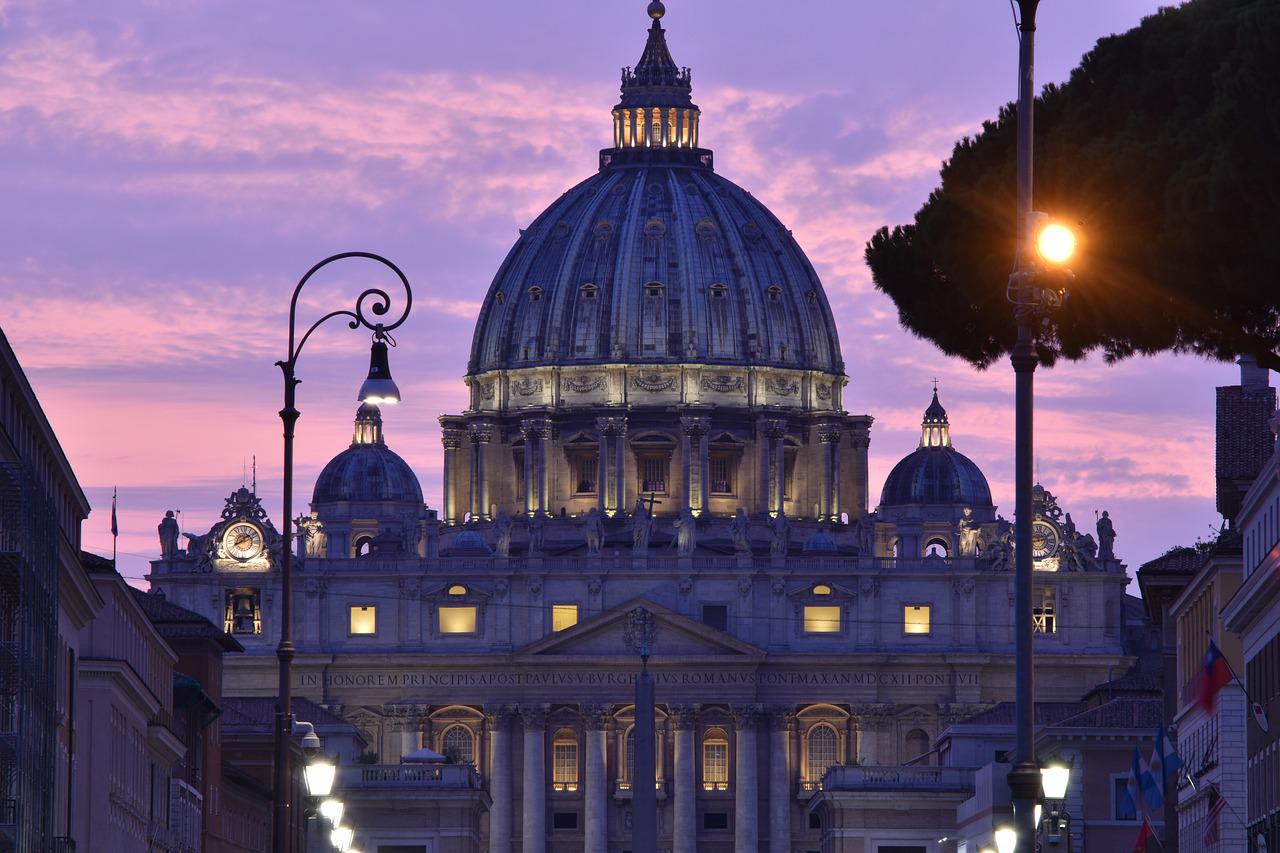The LGBT revolution is attempting to take over the Church

From “sins that cry to heaven for vengeance” to “inclusive ethics”. This is how the LGBT ideology is starting to erode the Church’s foundations.
Grzegorz Kucharczyk
“I’d rather be thrown into the cistern, as it happened to the patriarch Joseph, who accused his brothers of the greatest crimes in front of his own father (Gen. 37:24), than be like priest Eli (1 Samuel 2:23-26), a witness to the crimes of his sons, who kept silent so as not to incur God’s wrath on them. Why do you condemn me? What I now do against promiscuity, St. Jerome did against the Arians, St. Augustine did against the Manichaeans and Donatists”.
The quoted words come from the 11th-century treatise “Liber Gomorhianus” (“Book of Gomorrah”), written by Cardinal Peter Damiani. This Doctor of the Church was one of the leading figures of a movement aimed at the renewal of the Church “in capita et in membra” (in head and in members). This movement went down in history as the “Gregorian Reforms” – from the figure of Pope St. Gregory VII (1073-1085). It is usually associated with the so-called “struggle for investiture”, that is, the dispute between the papacy and the empire, the symbolic culmination of which was the humbling of the cursed Emperor Henry IV before Gregory VII at Canossa.
However, the emancipation of the Roman Church from the power of the emperors (and German kings at the same time) was not the beginning, but the culmination of a movement of real renewal of the Church. First it had to free itself from the heavier manacles – the neglect of proper divine worship and moral discipline among the clergy. The laborious work continued for long decades behind the walls of the growing Benedictine congregation of Cluny, which set itself the goal of returning to the splendor of the liturgy and the austerity of the original rule of St. Benedict.
The author of “The Book of Gomorrah” was associated with this spirituality and understanding of the reform of the Church, devoting this entire treatise to a critique of examples of moral decay among the clergy. At the head of this list of cases of corruption of those who should lead the multitudes of the faithful to salvation, the Doctor of the Church mentioned the scourge of homosexuality, which was spreading, as St. Peter Damiani emphasized, among priests. Having adopted such a “lifestyle”, they wanted to hear nothing about the need to renew the Church in “the head” (the papacy) and “members” (the clerical state).
The quoted words of “The Book of Gomorrah” were the author’s response to the already emerging accusations at the time that proponents of radical purification of the Church from moral corruption were sinning with a lack of mercy towards flawed human nature. A rhetorical question was directed at St. Peter Damiani: “Wouldn’t it be more merciful not to know about such atrocities?” The Doctor of the Church answered as quoted, and added: “My conscience supports me. I do not seek favor with any mortal. I do not fear the wrath of anyone except God. The testimony of my conscience is what I appeal to.”
Civilizational consequences of fighting sin
Fortunately for the Church and the civilization that grew up alongside it, such people of conscience formed in the glow of truth were more numerous in the 11th century than those who confused mercy with leniency. If we consider the fact that the program contained in the “Book of Gomorrah” ultimately contributed to the emancipation of the Church from the predominance of secular power, that is, the triumph of Latin civilization over the “Byzantines”, that the Church thus freed contributed to the flourishing of the civilization of Christianitas with its ethos of chivalry, Gothic cathedrals and universities – it is clear that the struggle against moral decay among the clergy (led by sodomy) had civilizational consequences that lasted for centuries.

In the era in which St. Peter Damiani lived, the teaching that the “sin against nature” (sin of sodomy) – as homosexuality was called – belonged to “sins that cry to heaven for vengeance” was nothing new. It belonged to a centuries-old tradition. It should be noted that the founders of the Protestant Reformation dealt with the issue in a similar way. In Geneva, governed according to the teachings of John Calvin, sodomy was punishable by death.
What is different is that some of the medieval heretical movements treated the practice of homosexuality as a way of fighting against the body, which is the work of an “evil God”. In this way, sexual orgies were justified by some Manichaeans, known in medieval Europe as Cathars (Albigensians).
Cases of homosexuality among the clergy were fought by the tribunals of the Holy Inquisition (both the Roman one – subordinate to the Pope and bishops, and the Spanish one – subordinate to the state authorities). This was seen as much a manifestation of moral degeneration as a symptom of contamination with heresy (suspicion of Manichaeism).
We’re already going to completely change the Church…
The Catechism of the Catholic Church, published in 1994 by St. John Paul II, does not explicitly qualify homosexuality as a “sin that cries to heaven for vengeance”. It does, however, treat active homosexuality (for a distinction is made between acts and inclinations) as an “intrinsically disordered” act. Almost 30 years after the Catechism was published, even calling homosexual acts “intrinsically disordered” is problematic for many bishops, led by the current Bishop of Rome, who – uttering the now famous words: “Who am I to judge them?” in response to a question about his attitude toward homosexuals (or “LGBTQ people” more broadly) – made it clear that he is as far as possible from the “unmerciful” attitude of St. Peter Damiani and those who would like to follow the program of the 11th-century Doctor of the Church in our century.
The prediction of Pope Francis’ highly esteemed Cardinal Walter Kasper in June 2012, who less than a year before Benedict XVI’s abdication, stated during the proceedings of the German Catholic Convention in Mannheim: “In 10, 20 years, the Church will look very different from what it is today, and will more closely resemble the early Church”, is partially becoming a reality before our eyes. The German cardinal’s prediction only partially came true, as only the first fragment of his sentence is consistent with reality in 2022. The Church – especially in terms of its approach to the indissolubility of the sacrament of marriage or to “LGBT people’ – does indeed look very different than it did back in 2012. No small part of the credit for this goes to Cardinal Kasper, who uttered these words, and who in 2014 was among the main promoters of planting an “atomic bomb under Catholic teaching on marriage” (Prof. J. Seifert) during the synod on the family (the so-called divorce synod).
It certainly has nothing to do with the Church of the first centuries, which did not know the concept of “pastoral accompaniment” now used to justify a life of sin, including the sin traditionally described as “crying to heaven for vengeance”. The harsh penances imposed on sinners in the Church of the first centuries certainly do not fit into Cardinal Kasper’s promoted “revolution of tenderness and mercy” as a smokescreen for the gradual dismantling of Catholic teaching on family life and human sexuality.
Rahner set the example
The German cardinal knows what he is talking about, and he knows how to execute his plan. He comes, after all, from a Church that in half a century has gone from rebelling against the Magisterium upholding opposition to contraception in Paul VI’s 1968 encyclical “Humanae vitae” to blessing “same-sex unions” in 2020. In 1968, the extremely influential (not only in Germany) theologian, Fr. Karl Rahner – his disciples include Cardinal Kasper – justified the need to reject the “rigorism” of Paul VI’s encyclical, claiming that, “admittedly, it presents a clear position, but it does not prove…,” that the doctrine it encompasses is not irrevocable, and that Catholics are called upon to resolve everything in their conscience, that the document indicates a “target norm” which, in the likeness of the horizon line, is unattainable, and at most can only be approached.
The Rahnerian matrix is used by German clergy today, justifying their decisions to bless “same-sex unions” in exactly the same way. The Church’s teaching with regard to homosexual acts, they say, is a bar set too high and which one can only approach. The most important thing is conscience (zero mention of how it is formed) and happiness understood as well-being and physical pleasure. There is also the notion of “inclusive ethics” (“let’s exclude no one”), to which the Metropolitan of Munich Cardinal Reinhardt Marx – former president of the German Bishops’ Conference and today one of the main promoters of changing the Church’s approach to homosexuality as part of the so-called “synodal way” – refers to.
Advocates of “inclusive ethics” dominating the German “synodal way” often refer to mercy in their plans to subvert the Church’s moral teaching. It is worth recalling in this context the words that St. John Paul II said to the German bishops gathered in Fulda in 1980: “Many would like to participate in the life of the Church, but they do not see the connection between the world in which they themselves live and the principles of Christian life. They think that the Church only persists in its norms because of its strictness, and that it opposes the mercy that Jesus showed in the Gospel. It overlooks the tough demands of Jesus, his words: ‘Go and sin no more’ (John 8:11). It often appeals to its own conscience in these matters, forgetting that the conscience is an eye that does not possess light itself, but has it only when looking into the true Source of Light.”
The whole problem is that, according to proponents of “inclusive ethics”, the Gospel scene alluded to by John Paul II would end quite differently, with the words: “Go and worry no longer.” Because, after all, there is no sin, there is only another form of love, another form of fidelity and another expression of respect.
The “yes, but” strategy
In October 2014, Cardinal Marx stated in a press interview that, “exclusion is not the language of the Church”. Only a union between a man and a woman can be recognized as a sacramental marriage, “but one cannot say that everything is black or everything is white, all or nothing, because, the president of the German Bishops’ Conference stressed, “if there is a homosexual union living in fidelity for more than 30 years, one cannot say that it is nothing.”
Here, in all its glory, we are dealing with the “yes, but” attitude that the German bishops already displayed when rejecting “Humanae vitae” (“yes” – verbally we are in favor of banning contraception, “but” – everything is decided in the conscience of the spouses). A similar pattern of argumentation is used today when pushing for changes in the German Church regarding the teaching on homosexuality. Interestingly, this way of thinking is also presented by hierarchs who are considered “conservatives” in the German episcopate (it is hard to deny that today this is an extremely easy task).

The Archbishop of Cologne, Cardinal Rainer Maria Woelki – who now seems to be distancing himself from the most revolutionary ideas of the promoters of the German “synodal way” – speaking in 2012 at the Convention of Catholics (Katholikentag), while still archbishop of Berlin, stated that “when two homosexuals take responsibility for each other, their relationship is long-lasting and faithful, this relationship should be treated like that of heterosexuals”. In general, the archbishop of Berlin at the time believed that, “one who takes the catechism [of the Catholic Church] seriously should not see homosexual unions as merely an offense against the natural law”.
Berlin’s Archbishop Woelki became the first German hierarch since September 2011 to hold regular meetings with representatives of Berlin’s LGBT community. In the fall of 2012, the Berlin Union Against Homophobia awarded Cardinal Woelki its annual Respektpreis award for those leading the way in the fight against “homophobia”. The newly-appointed cardinal refused to accept the award because for him as a Catholic, “respect for all people is a matter of principle”.
Ratzinger’s disciple and the “bearded woman”
For a long time, the metropolitan of Vienna, Cardinal Christoph Schönborn, who belongs to the so-called Ratzinger Kreis, a group of the most prominent disciples of Rev. Prof. Joseph Ratzinger (the future “armored cardinal” and Pope Benedict XVI), was considered a “conservative”. In 2012, Cardinal Schönborn ordered one Viennese parish priest, hesitant to accept an active homosexual into the parish council, to change his decision. The Vienna metropolitan justified his position on the grounds that the composition of the parish council “reflects the vitality of the Church. In their diversity, they reflect the diversity of current attitudes toward life and faith”.
In May 2014, the Viennese cardinal publicly congratulated the “bearded woman” (Conchita Wurst), who won the Eurovision Song Contest, in the following words: “As we know, there are many colors in God’s garden. Not everyone who was born a man feels like a man, and the same applies to women. Such people deserve the same respect to which we are all entitled as human beings.” On this occasion, Cardinal Schönborn expressed his regrets that “sexual minorities constantly face intolerance”.
On the other hand, in November 2014, in an interview with the Italian daily Corriere della Sera, the same purple shared with readers the news that for years he has known a homosexual couple from Vienna who live “in fidelity”. The Austrian cardinal shared his elation at seeing their behavior in a moment of illness: “It was wonderful, humanly, and Christianly, to see how one cared for the other”. “Such things should be recognized” – concluded the Viennese cardinal.
Damiani or Marx?
In the days of St. Peter Damiani, a spiritually and morally renewed Church benefitted the surrounding world. Today, one can hardly expect German or Austrian Christian Democrats to raise objections to the “marriage for everyone” projects being pushed by the Left, when within the Church itself those who are supposed to strengthen the brethren in the faith are faltering.
Towards the end of 1966, blessed Cardinal Stefan Wyszyński, who, along with Cardinal Karol Wojtyła, was among those few members of the College of Cardinals who in the 1960s firmly stated non possumus to the plans to “adapt” the Church’s moral teaching to the needs of “modern man”, said: “The language of Christ has been difficult from the beginning, and to this day is an insult to unsaved ears. Most kindly, we are little interested in the fact that it is hard. What is important to us is that it saves, that it is the salvation of the world”.
The question before the Church today is simple and dramatic at the same time: will it follow the vision of the renewal of St. Peter Damiani and Blessed Cardinal Wyszyński or the one presented by Cardinals Marx, Schönborn and co.? Hard words of truth leading to salvation, or a convenient “inclusive ethic” adapted to the synodal “road to hell”?
This article was published in September 2022 in “Do Rzeczy” weekly magazine.




